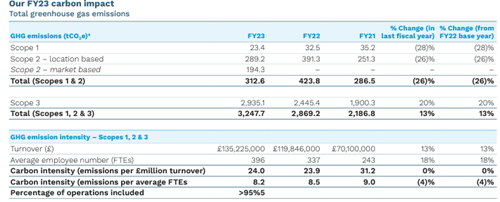
Reducing our carbon footprint
We our committed to becoming Net Zero as a Group across all scopes by 2040 in line with the SBTi.
We committed to a science-based reduction target of 42% on our direct emissions in the near term (2030) from our FY22 base year and to reduce Scope 3 emissions as part of this plan. We plan to validate our commitment to achieve Net zero with the SBTi in FY24.
Please refer to our latest Annual Report to view our full SECR report.
S1, S2, S3 EMISSIONS FY23
Our current year carbon footprint
In FY23, 10% of emissions fall into Scope 1 and 2, direct emissions associated with our operations. Purchased electricity (65%) was the largest contributor to our Scope 1 and 2 emissions, followed by purchased heat at 28%.
90% of the Group’s emissions fall into Scope 3, our corporate value chain emissions. Scope 3 emissions, which are under a reporting organisation’s influence but not control, typically make up the largest proportion of a company’s carbon emissions, particularly when Scope 3 emissions are comprehensively covered. In FY23, the Group’s largest emission Scope 3 emission source continues to be from purchased goods and services (35% of Scope 3 emissions), which arise from the hosting of our online platforms in data centres operated by others. Other significant Scope 3 categories include the use of our products (21% of Scope 3 emissions), employee commuting and remote working (10% of Scope 3 emissions) and business travel (12% of Scope 3 emissions)


Our FY23 impact
As in previous years, the Group accepts that our overall emissions have and may continue to rise as a growing and acquisitive company. Our total absolute emissions across all scopes have increased by 13% in FY23. Scope 3 has increased by 20%, which predominantly is due to growth in our business and the associated growth in our value chain emissions. Scope 1 emissions have, however, decreased by 28% and Scope 2 (location based) have also decreased by 26%, with an overall 26% reduction seen in our Scope 1 and 2.
The reduction in our Scope 1 and 2 emissions is predominantly due to the relocation of our Omaha office to a smaller, more carbon efficient premises. The impact of this move was slightly offset by the acquisition of ESN and the organic growth of our business.
Our carbon intensity metrics, our measures of carbon emissions as a proportion of our overall activity, have however either remained constant or decreased. Carbon intensity when compared to our turnover has remained constant, whist carbon emission per FTE have declined by 4%. This indicates that our carbon emissions are not increasing in line with our growth.
Reducing our impact
Our main focus this year has been to identify and agree upon reduction strategies to achieve our near-term target of reducing absolute Scope 1 and 2 emissions by 42% by 2030 (FY31) from a FY22 base year, led by the ESG Committee. We are on track to achieve this target with a reduction of 26% in our first year of reporting.
Whilst our relocation of our Omaha office has contributed significantly to achieving this target, we are aware that more needs to be done to reduce our direct emissions and we will continue to improve the energy efficiency of our offices. We have identified a number reduction strategies to implement in FY24 through a carbon survey of our six office locations. For example, these include:
• Setting standard heating and cooling temperatures to minimise wasted energy associated with Heating, Ventilation, and Air Conditioning (HVAC);
• Ensuring HVAC systems are not in use outside of hours;
• Switching off appliances when not in use and investigating energy efficient alternative technologies; and
• Updating to LED lighting throughout our offices.
Our future commitment
We will continue to take a rigorous approach to calculating our overall climate impact by improving our approach to emission calculations annually and working to reduce our absolute emissions, including our value chain emissions to achieve our science-based reduction targets. As our Scope 3 makes up 90% of our carbon footprint, we plan to develop a supplier engagement strategy to work with our suppliers to improve the accuracy of our carbon emissions and inform our future procurement decisions. We intend to validate our long-term Net zero target with the SBTi in FY24 and publish a transition plan to outline how we will achieve this.

